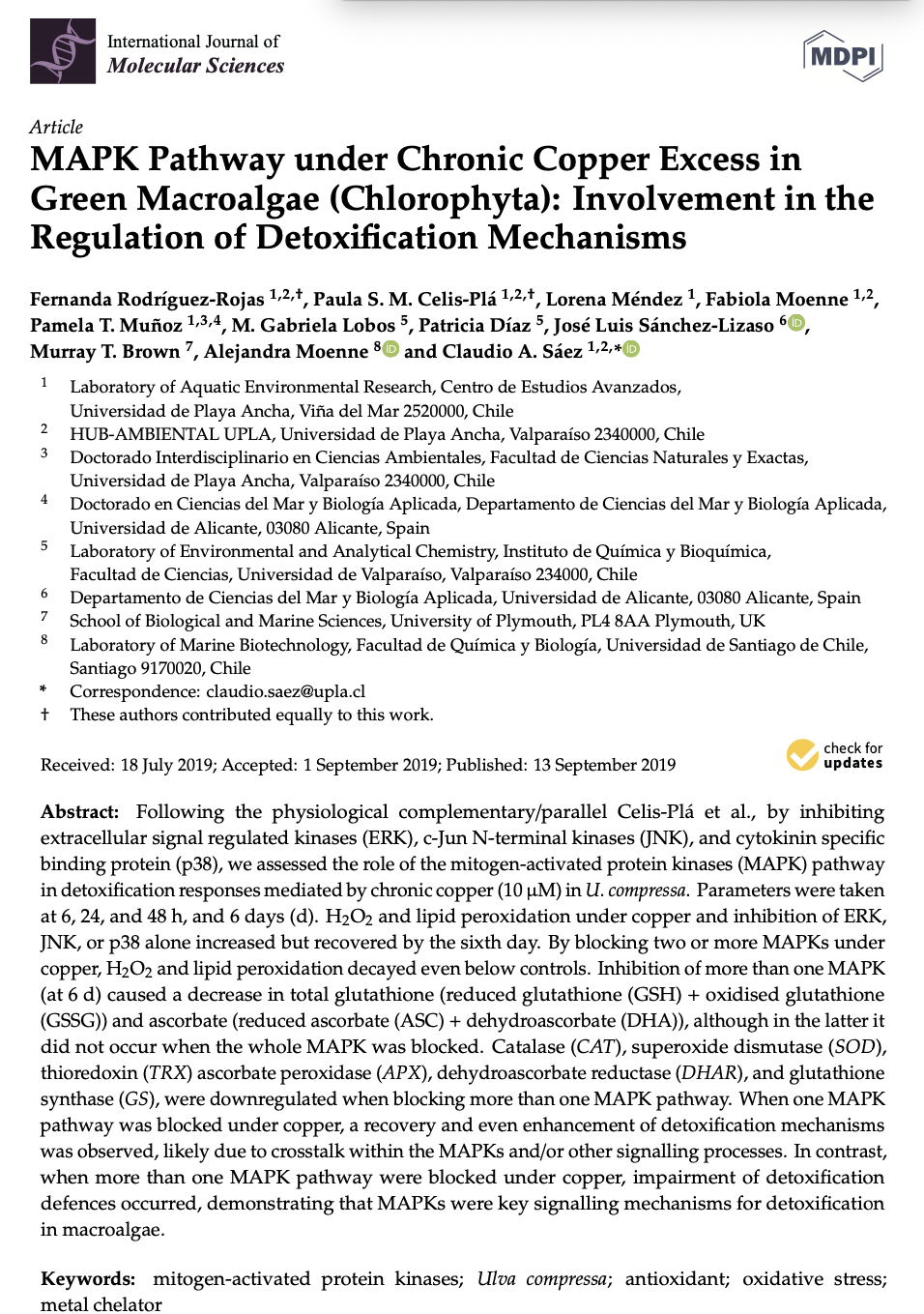
- June 02, 2020
MAPK Pathway under Chronic Copper Excess in Green Macroalgae (Chlorophyta): Involvement in the Regulation of Detoxification Mechanisms
Fernanda Rodríguez-Rojas,Paula S. M. Celis-Plá, Lorena Méndez, Fabiola Moenne, Pamela T. Muñoz, M. Gabriela Lobos, Patricia Díaz, José Luis Sánchez-Lizaso, Murray T. Brown, Alejandra Moenne and Claudio A. Sáez|Laboratory of Aquatic Environmental Research, Centro de Estudios Avanzados, Universidad de Playa Ancha, Viña del Mar 2520000, Chile, HUB-AMBIENTAL UPLA, Universidad de Playa Ancha, Valparaíso 2340000, Chile, Doctorado Interdisciplinario en Ciencias Ambientales, Facultad de Ciencias Naturales y Exactas, Universidad de Playa Ancha, Valparaíso 2340000, Chile, Doctorado en Ciencias del Mar y Biología Aplicada, Departamento de Ciencias del Mar y Biología Aplicada, Universidad de Alicante, 03080 Alicante, Spain, Laboratory of Environmental and Analytical Chemistry, Instituto de Química y Bioquímica, Facultad de Ciencias, Universidad de Valparaíso, Valparaíso 234000, Chile, Departamento de Ciencias del Mar y Biología Aplicada, Universidad de Alicante, 03080 Alicante, Spain, School of Biological and Marine Sciences, University of Plymouth, PL4 8AA Plymouth, UK, Laboratory of Marine Biotechnology, Facultad de Química y Biología, Universidad de Santiago de Chile, Santiago 9170020, Chile|2019|PLoS ONE|1495): e0216218
Previous studies have shown that copper-stressed green macroalgae display high levels of lipid peroxidation, enhanced activity of APC, consumption of glytathione and increased ascorbate. This suggests that antioxidant response is transcriptionally regulated in green macroalgae under chronic copper excess. The relationship of the mitogen-activated protein kinases (MAPK) signally pathway to the regulation of antioxidant responses has not been previously investigated fully. In this study, Ulva compressa (U. compressa) were exposed to chronic copper excess to study three main MPK pathways (ending in ERK, JNK and p38) and their roles in within antioxidant responses and detoxification mechanisms associated with metal chelation. This was done through studying the expression of the selected genes (CAT, SOD, TRX, APX, DHAR, GS and 18S) over time using RT-qPCR performed on the MIC qPCR cycler. It was observed that when one MAPK pathway was blocked under copper, there was recovery and even enhancement of detoxification mechanisms, likely due to crosstalk within the MAPKs and/or other signaling processes. However, when more than one MAPK pathway as blocked under chronic copper stress, impairment of detoxification defenses occurred, demonstrating that MAPKs were key signaling mechanisms for detoxification in macroalgae.
Read More